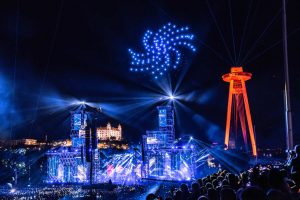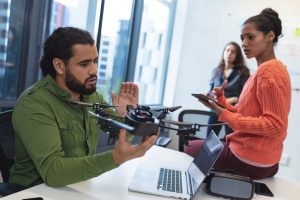What Is a Drone?
Drones are unmanned aerial vehicles (UAVs) that fly either by remote control or autonomously. Once used mainly for military purposes, drones are now part of everyday life – used for aerial photography, deliveries, inspections, or simply as a fascinating hobby.
Modern drones combine sensors, computing power, and precise control in a compact design. But how exactly do they work?
How Does a Drone Stay in the Air?
Drone flight is based on a simple yet powerful principle: lift generated by rotors.
Most consumer drones – typically quadcopters – have four rotors. Each consists of a propeller driven by an electric motor. The drone’s frame holds all the components together. Rapid spinning of the propellers generates lift – similar to a helicopter. Some rotors spin clockwise, others counter-clockwise, which balances rotation and keeps the drone stable.
By adjusting motor speeds, the flight direction changes:
All rotors faster = Drone ascends
All rotors slower = Drone descends
Left/right faster = Tilt and turn
Front/back faster = Forward or backward movement
This balance is managed by the flight controller.
Key Components of a Drone
To make all this work, drones are built with a combination of crucial parts. There are different types of drones, primarily distinguished by the number and type of motors or propellers. Especially for DIY drones, using your own components adds fun and flexibility for maintenance.
Flight Controller
The drone’s “brain.” It gathers sensor data and controls the motors. It ensures stability, processes commands, and compensates for unintended movements. Gyroscopes play a vital role by providing data that allows precise flight control, reacting to pilot input and environmental factors like GPS or air pressure.
Propellers & Motors
Motors spin the propellers with precision. High-quality drones use brushless motors for better efficiency and durability. The type and arrangement of motors and propellers affect speed, lift, and overall stability.
Battery & Power Supply
No energy, no flight. Most drones use LiPo (lithium polymer) batteries that offer high power with low weight – but limited flight time (typically 15–30 minutes).
Sensors
Essential for stability and positioning, drones use a variety of sensors:
Gyroscope & Accelerometer – detect rotation and movement
Barometer – measures altitude
GPS – tracks position
Compass – for directional alignment
Some models also include ultrasonic or optical flow sensors for indoor stability.
Camera & Gimbal
Many drones feature cameras for photos, videos, or live streaming. A gimbal stabilizes the camera for smooth footage, even in windy or fast-moving situations.




